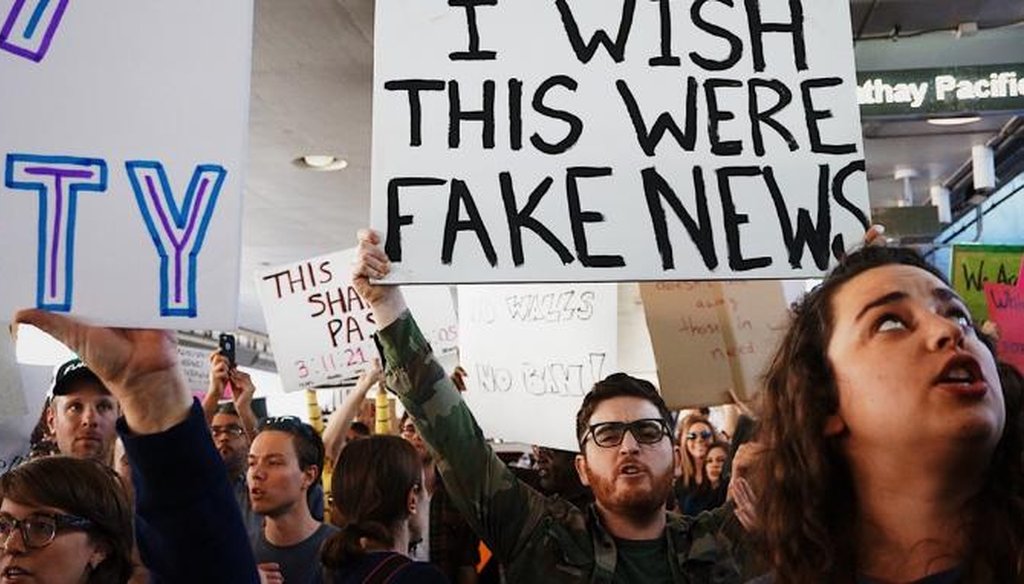Stand up for the facts!
Our only agenda is to publish the truth so you can be an informed participant in democracy.
We need your help.
I would like to contribute

PolitiFact offers its guide to spotting fake news.
As you scroll through posts on Facebook and spot the latest meme or attack on a politician, do you find yourself wondering if it is true?
PolitiFact is here to help. To celebrate International Fact-Checking Day, we’re sharing our advice on sorting through the massive amount of news on social media.
April 2 is International Fact-Checking Day project of the International Fact-Checking Network, in partnership with fact-checking organizations around the world, including PolitiFact. Make sure to follow @factchecknet and #FactCheckIt on Twitter to take part in the global conversation.
Here are eight tips to help you spot fake news.
Be skeptical
Sign up for PolitiFact texts
If a post strikes you as outlandish, put the headline in a search engine and see if you can find some mainstream news accounts on the same topic. For example, if former President Barack Obama had actually appeared in court in handcuffs, it would have been covered by multiple news outlets worldwide — not just some random blogs.
Run a URL background check
Some websites with glaringly inaccurate stories have an "about" section on their homepage or on Facebook that identify their content as satire. Take the fine print from America’s Last Line of Defense as an example: "Nothing on this page is real. It is a collection of the satirical whimsies of liberal trolls masquerading as conservatives. You have been warned." Other fake news websites have names that are similar to real websites but on closer examination are a little different. For example, The Politico News is a fake news website with a similar name to Politico, a real news website.
Scour social media history for bias
When the stock market fell in February, a man in England named Shaun Usher shared what appeared to be a years-old tweet on the topic from Donald Trump. Saying "there’s *always* a tweet," Usher linked to a supposed Trump tweet that said, "If the Dow Joans ever falls more than 1000 ‘points’ in a Single Day the sitting president should be 'loaded' into a very big cannon and Shot into the sun at TREMENDOUS SPEED! No excuses!"
Some of Trump’s past tweets have come back to haunt him as commander in chief, but this one never happened. Usher had to make it clear that his previous tweet was a joke: "Sweet mother of god. Not for one second did I think people would believe that to be genuine."
A glance back at Usher’s Twitter feed showed he had been critical of Trump in the past, once calling him the "dumbest sack of meat."
Real or Fake? Take the fake news quiz to find out!
Google the quotes
Many false stories have incendiary quotes. A story that said the U.S. Supreme Court ruled that public schools "will not teach the tenets of Islam or Sharia Law" included alleged quotes by U.S. Supreme Court Justice Neil Gorsuch. When we searched for the quote, we found it only on suspicious blogs — and in fact-checks that debunked the claim.
Put authentic quotes in context
Another tactic of fake news generators is to distort real comments from politicians and celebrities into the worst possible meaning. One story said that Oprah Winfrey told a Fox News host "all white people have to die." But her full comments, told to a BBC interviewer, had more context: "As long as people can be judged by the color of their skin, the problem is not solved. There is a whole generation — I said this for apartheid South Africa, I said this for my own community in the south — there are still generations of people, older people, who were born and bred and marinated in that prejudice and racism, and they just have to die."
Consider the sources in the story
Some stories appear to be legitimate because they include quotations from experts and real-sounding reports. Sometimes the experts are fake. And other times, the sources are not as solid as they seem.
One headline about the FDA announcing "vaccines are causing autism," for example, linked to a 2005 brochure for Tripedia, which said adverse side effects include autism. But the brochure also stated, "Because these events are reported voluntarily from a population of uncertain size, it is not always possible to reliably estimate their frequencies or to establish a causal relationship to components of Tripedia vaccine." A credible story about the FDA and a vaccine would include interviews with an FDA official as well as someone from the drug maker. That wasn’t the case here.
Read beyond the headline
Some headlines are clickbait and don’t fully reflect the nuances in the story. Take the headline "Ohio student suspended for staying in class during National Walkout Day." It creates the impression that the student was suspended simply for skipping the walkout one month after the Parkland shooting. The story itself stated that the student was suspended for choosing to stay in a classroom rather than go to the school-sanctioned alternative to the protests, study hall. A statement from the school district said that students had to be in a supervised location.
Watch out for doctored photos
Real images can easily be manipulated to create a phony impression. After Marjory Stoneman Douglas student Emma Gonzalez appeared in a video by Teen Vogue ripping up a gun-range target poster, someone then doctored the image to show Gonzalez ripping up the Constitution. A search on Twitter showed that some users pointed out that the image was doctored including Don Moynihan, a professor of public affairs at University of Wisconsin-Madison. Moynihan, like most professors, posts an extensive bio and resume on a public website, which helps viewers determine his credibility.
Some fake news stories use real, yet unrelated images. By using Google for a reverse image search, you can find the actual source of the photo. (Sadly, this trick does not work for video — try these tips instead.) For example, a fake story about a murdered NFL attorney (who didn’t even exist) included a photo of two police officers at a crime scene. We searched Google images and found it matched an Associated Press photo of a crime scene near the site where a police officer was fatally shot in the Bronx in July.
Our Sources
See individual fact-checks for sources






































